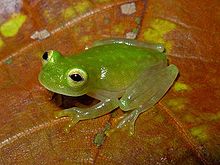Hyalinobatrachium fleischmanni
| Hyalinobatrachium fleischmanni | |
|---|---|
 |
|
| Scientific classification | |
| Kingdom: | Animalia |
| Phylum: | Chordata |
| Class: | Amphibia |
| Order: | Anura |
| Family: | Centrolenidae |
| Genus: | Hyalinobatrachium |
| Species: | H. fleischmanni |
| Binomial name | |
|
Hyalinobatrachium fleischmanni (Boettger, 1893) |
|
| Synonyms | |
|
|
Hyalinobatrachium fleischmanni, the Fleischmann's glass frog or northern glass frog, is a species of frog in the Centrolenidae family. It is found in the tropical Americas from southern Mexico to Ecuador. Specifically, these frogs occur in Mexico, Belize, Costa Rica, El Salvador, Guatemala, Honduras, Nicaragua, and Panama, Colombia, and Ecuador. Notice that this and related species have often been confused with each other, and the exact distribution depends on the source.
The specific name fleischmanni honors Carl Fleischmann, a collector in Costa Rica in the 1890s.
Glass frogs have similarities to tree frogs. They look very close to the naked eye except glass frog's eyes point forward and are golden. During the day, these frogs camouflage themselves under leaves but above water. Male glass frogs are 19–28 mm long while females measure from 23–32 mm long. They have a green semi-translucent color with yellow translucent hands. Their skin has dots which matches that of the leaves in the area. When confronted or approached, they tend to freeze up and not move. It is not specifically known what the glass frog eats, but it is assumed that they feed on small insects.
Also known as the Northern Glass Frog, this frog’s physical features include primarily green skin, pale yellowish spots, yellow fingertips and translucent skin covering its stomach. A sheet of guanine stretches over several internal organs, such as the heart, but leaves others parts such as the liver exposed for viewing as it only covers half of the frog’s underbelly. They also possess a white vocal sac that can be used to produce sounds for mating. Male frogs have a noticeable hook protruding from its spine, presumably used to fight other frogs, defend its territory or the eggs. They are fierce fighters who will occasionally engage in a wrestling match with other intruding frogs. The female species are slightly larger and lacks this particular feature. There have been more than 100 reported glass frogs throughout Central and South America. 13 species can be found in Costa Rica. Adults tend to be more active during the night when there is rain to keep their skin moist and from drying out. However, strong rains can kill them because their bodies are so fragile. A simple direct shot from a raindrop has been known to kill a glass frog.
...
Wikipedia

